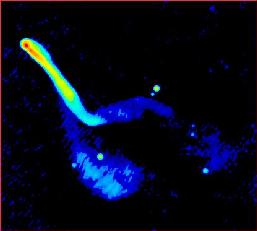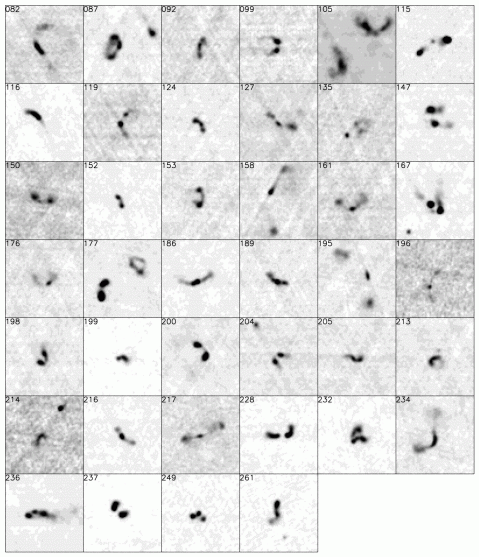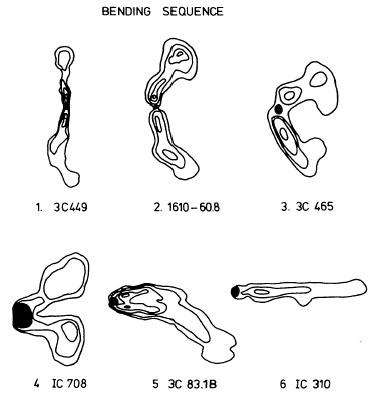More Information on Tailed Radio Galaxies (Part 2)
This is the second half of a detailed description of tailed radio galaxies from RGZ science team member Heinz Andernach. If you haven’t yet read the first part, it’s here: please feel free to leave any questions in the comments section.
Apart from distance or angular resolution, another reason for causing a NAT may be projection of the inner jets along the line of sight, as seems to be the case for NGC 7385 (PKS 2247+11). In the low-resolution image above, the inner jets are not resolved, but the corresponding far outer tails start to separate widely about half-way down their length. At much higher resolution:
the two opposite jets can be clearly seen to emanate from the very core, the central point-like source in this contour plot. However, the jet heading north-east (upper left) has been bent and diluted by almost 180° such that it runs behind the other jet for about 200 kpc (about 650,000 light-years) before the two jets separate and can be distinguished again in the lower-resolution image. The combination of these images is also a good example showing that different interferometers (large and small) are needed to show all features of a complex radio source.
However, not all apparently tailed radio sources would show their double jets near the core at high resolution. One curious example is IC 310, among the first “head-tails” to be discovered, has stubbornly resisted to show double jets, and is now accepted as a genuinely one-sided jet of the type that BL Lac objects, implying that its jet points fairly close to our line of sight.
An atlas of the radio morphologies in general of the strongest sources in the sky can be found here. Several NATs and WATs can be distinguished on the collection of icons. However, this atlas only comprises the 85 strongest sources in the sky. The enormous variety of bent radio galaxies present in the FIRST radio survey was explored with automated algorithms by Proctor in 2011, who tabulated almost 94,000 groups of FIRST sources attaching to them a probability of being genuine radio galaxies of various morphological types. The large variety of bent sources can be seen e.g. in her Figures 4, 7 and 8. However, this author made no attempt to find the host galaxies of these sources. Users of Radio Galaxy Zoo will eventually come across all these sources and tell us what the most likely host galaxy is.
Distant clusters of galaxies, important for cosmological studies, tend to get “drowned” in a large number of foreground galaxies present in their directions, so they are difficult to be distinguished on optical images. One way to find such clusters is by means of their X-ray emission, but since X-rays can only be detected from Earth-orbiting telescopes like ROSAT, ASCA, XMM-Newton, Chandra and Suzaku (to name only a few), this is a rather expensive way of detecting them. A “cheaper” way of looking for distant clusters is to use NATS and WATs as “beacons”. In fact, authors like Blanton et al. (2001) have followed up the regions of tailed radio sources and see the variety of morphologies:
Note that several of these WATs appear like twin NATs, but actually they are a single WAT, being “radio quiet” at the location of their host galaxies (not shown in the image above), but their jets “flare up” in two “hot spots” on opposite sides of the galaxy where they suddenly bend. The authors confirmed the existence of distant clusters around many of them. So, whenever RGZ users identify such tailed radio galaxies, we know that with a high probability we are looking in the direction of a cluster of galaxies.
An excellent introduction (even though 34 years old!) to radio galaxy morphologies and physics is the article by Miley 1980 (or from this alternate site). This author already put together a few well-known radio sources into what he called a “bending sequence”:




